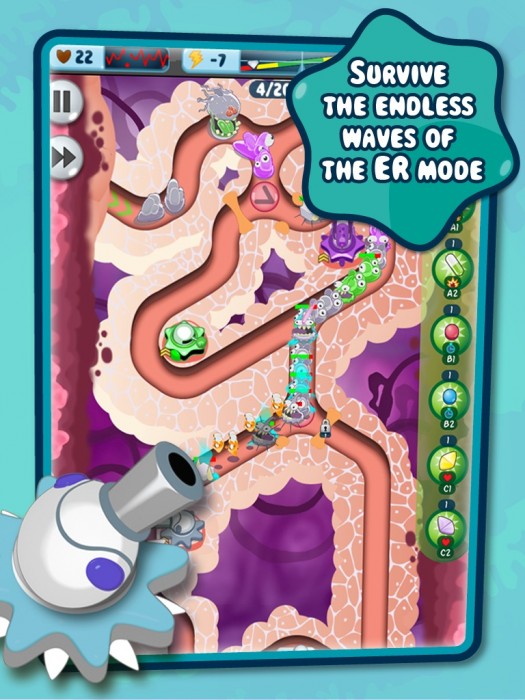![]() As a longtime fan of tower defense games, I’m continually impressed at the length iOS devs will go in order to try and breath fresh life into the genre. Human Defense ($0.99), for instance, charges you with defending various body parts from viruses by placing immunity system towers. While that alone offers some novelty in the genre, Human Defense goes a bit further integrating puzzle and reflex mechanics. This makes the game at the very least an interesting TD experience.
As a longtime fan of tower defense games, I’m continually impressed at the length iOS devs will go in order to try and breath fresh life into the genre. Human Defense ($0.99), for instance, charges you with defending various body parts from viruses by placing immunity system towers. While that alone offers some novelty in the genre, Human Defense goes a bit further integrating puzzle and reflex mechanics. This makes the game at the very least an interesting TD experience.
As a tower defense game, Human Defense is a lot more active than other titles in the genre. Yes, there are set spots to place your towers, along with enemies traveling down pre-determined paths. There’s also a standard three-star ranking and scoring system that seems prevalent in most games. But, you’ll also find some interesting mechanics such as multiple routes with switches, as well as a health system that requires constant supervision during a match.
 Another major difference is in resource allocation. Each tower requires energy to build, with the resource represented by units such as carbohydrates and proteins, which take the same paths as the enemy. In order to build the tower, you actually have to guide these building blocks to the construction site, making sure the appropriate routes are open. Upgrading your tower without enough energy units interacting with it leaves it useless for the round, adding to the strategy of keeping track of the building blocks. You can also let your energy units travel the entire route and enter the body part’s system, making it healthier (to a certain extent). It’s an interesting twist and is a lot more engaging than the usual passive resource systems.
Another major difference is in resource allocation. Each tower requires energy to build, with the resource represented by units such as carbohydrates and proteins, which take the same paths as the enemy. In order to build the tower, you actually have to guide these building blocks to the construction site, making sure the appropriate routes are open. Upgrading your tower without enough energy units interacting with it leaves it useless for the round, adding to the strategy of keeping track of the building blocks. You can also let your energy units travel the entire route and enter the body part’s system, making it healthier (to a certain extent). It’s an interesting twist and is a lot more engaging than the usual passive resource systems.
Meanwhile, enemies are generally divided into categories that are strong, weak, or normal against the various towers. Later levels introduce the concept of antibodies, where enemies appear as one of two colors and are completely immune to towers not sharing that same color (and require you to use a special tower to “scan” the color and build antibodies to change tower colors). The multiple routes mentioned earlier become critical in later levels, as you essentially need to manage your energy and build two different tower paths and direct the right enemies down the appropriate paths.
In this sense, Human Defense feels more involved than most other tower defense games. The limited resources and tower placement spots also add a puzzle element that makes it a bit more challenging as well. This leads to less flexibility in coming up with a winning strategy for each mission as its obvious that there is a ‘right’ way to pass most levels, and it also creates a strange difficulty curve that is contingent on how well you understand each level at the onset. Personally, I’m more of a fan of looser tower defense titles, but I can appreciate the twist on the genre that Human Defense is trying to accomplish.
Human Defense also comes with an in-game shop full of one-use items that affect your gameplay for the next map (lower building costs, increase tower attack power, e.t.c.) that can be purchased with coins. Coins are earned at the completion of each map, or you can conveniently pick them up via IAP. On one hand, every level can eventually be passed with enough planning without resorting to the one-use items. However, achievement hunters and leaderboard aficionados will most likely need to turn towards those items (and possibly spring for more coins via IAP) in order to fully ‘complete’ the game, which will inevitably perturb some gamers.
With only 15 total missions in ‘Adventure’ mode (along with a nonstop ‘Emergency Mode’), replayability is probably the most significant issue for Human Defense at this point (although more chapters should be patched into the game eventually). In any case, gamers looking for a novel twist on tower defense should definitely consider checking out Human Defense. While the uneven difficulty and IAP may turn off some, I enjoyed the successful melding of puzzle and tower defense.